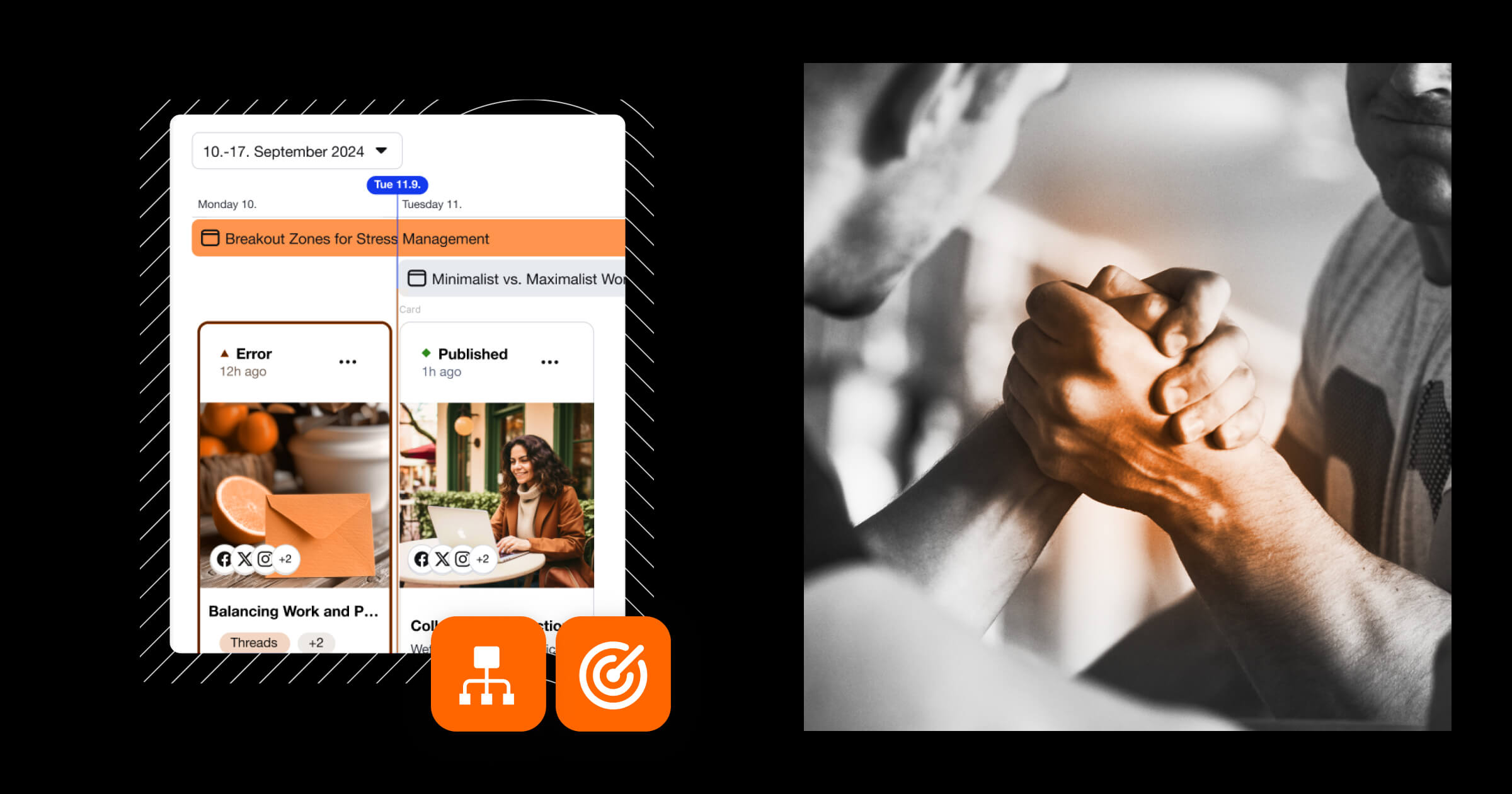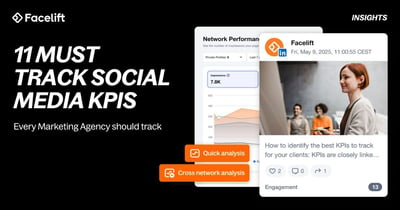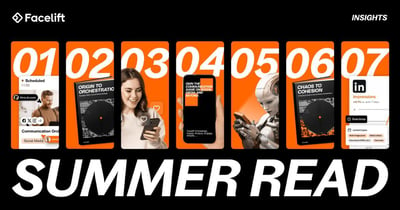In social media strategy, there’s one shadowy corner that marketers are still trying to master: "dark social."
No, despite its rather nefarious-sounding name, it’s not the latest crime drama or some sort of covert data-stealing group.
Dark social is the invisible layer of content sharing that happens outside of traditional, trackable channels. It includes private messaging apps, email, and direct link sharing that analytics tools often can’t trace.
And yes, it could be playing an absolutely massive role in how your brand's content travels across the Internet.
Let’s dive into what dark social is, how it works, and why it’s essential to bring it into the fold of your social media orchestration and content strategy.
What is dark social?
Most simply, dark social refers to web traffic and content sharing that can’t be traced back to a specific source.So, your UTM parameters aren't picking it up. It won't show in your fancypants analytics data and reporting it will be challenging to say the least.
When someone copies a link from your website or social post and pastes it into a WhatsApp message, an email, or a Slack channel, that’s dark social in action.
Analytics tools like Google Analytics might record the traffic, but they can’t pinpoint where it came from.
This is why it's "dark".
Examples of dark social sharing channels:
- Messaging apps: WhatsApp, Facebook Messenger, Signal, Telegram.
- Emails: Content shared directly in personal or professional correspondence.
- Copy-paste URLs: Shared casually into private forums, group chats, or even SMS.
According to studies, a staggering 63% of online shares happen via dark social.
Think about it: when’s the last time you tweeted an article versus DMing it to your friend?
When I see a funny Instagram story, I almost never reshare it as my own story. Instead, I DM it to people I talk to frequently. I don't share goofy cat content on my personal pages, even if I do occasionally find it amazing.
This is happening with your brand.
Why does dark social matter?
Dark social is the digital equivalent of word-of-mouth marketing—personal, trusted, and effective. People are more likely to click on a link shared by someone they know rather than an ad in their feed. I know I am
It's not an accident that this is how so many hackers get ahold of social media accounts. They impersonate your friend's compromised account, then they send you links under their guise. It works because you're so much more prone to opening it than if they shared something obviously out of character on their wall.
But here’s the catch: because dark social is difficult to track, businesses risk underestimating the true value of their content and missing opportunities to optimize for these sharing habits.
Key challenges:
- Lack of visibility: Analytics tools often lump dark social traffic into "direct traffic," giving you an incomplete picture of what’s working. If you're a content strategist of any sort, you've likely seen this "direct traffic" and sighed audibly because it's not as actionable as something like organic.
- Misattributed performance: You might credit paid ads or organic search for traffic that actually comes from private shares.
- Missed insights: Without visibility, you lose opportunities to understand audience preferences and behaviors.
How dark social works with social media orchestration
Now, let’s connect the dots.
Social media orchestration is about strategically aligning your social activities to achieve business goals. Dark social might seem like an outlier—how do you align something you can’t track? The answer lies in content and channel design.
1. Craft content worth sharing privately
Since dark social thrives on private, trusted interactions, focus on creating content that adds value in one-to-one conversations.
This could be:
- Informative guides.
- Emotional storytelling pieces.
- Shareable memes or infographics.
2. Embed traceability
UTM parameters are tags added to URLs that help you track from where your traffic originates.
For example, adding ?utm_source=email&utm_medium=direct A link shared in an email can show you exactly how much traffic that email generates via something like Google Analytics. This is crucial for dark social because it helps uncover hidden sharing patterns in private channels.
Facelift users can do this automatically when creating content with links with our custom shortener. These built-in UTM parameters are perfect for tracking performance without manual effort.
While UTMs can’t fully solve the mystery of dark social, they provide valuable clues about how your content spreads behind the scenes, and can help you pull back the curtain.
3. Integrate dark social into orchestration tools
Alignment is always key to social media orchestration. When your campaigns are designed with both public platforms and private sharing behaviors in mind, you maximize your reach.
For example, a blog post shared via an Instagram Story might inspire private discussions in WhatsApp groups, which can still funnel traffic back to your site if the content—and tracking—are designed properly.
Orchestration helps make sure that every campaign element, from metadata to shareable links, is unified and optimized to perform across all touchpoints. Whether content is shared publicly or privately, the system keeps your strategy cohesive and measurable.
Facelift’s tools, like Orchestrate, are designed to help you plan and publish content and optimize it for hidden sharing patterns like dark social.
Bringing content orchestration into the mix
Dark social isn’t just about social media; it stretches into email campaigns, content marketing, and even employee advocacy.
This is where content orchestration comes in—managing and aligning content efforts across every touchpoint.
Here’s how it connects:
- Unified messaging: By orchestrating your content strategy, you ensure that the tone, branding, and key messages remain consistent, whether a link is shared in a LinkedIn message or in a private MS Teams channel.
- Custom shareable content: Orchestration helps you create formats that thrive in dark social environments, like snackable stats, infographics, or easily shareable PDFs.
- Employee advocacy: Employees are powerful conduits for dark social. By enabling them to share curated content through tools like Amplify, you can tap into professional and personal networks in private spaces.
Measuring the immeasurable: Tips for dark social
It's obviously important to do everything you can to document and measure what is happening on dark social. Despite the challenges, there are still ways to do this, and mastering them could bring you a boost in web traffic or sales that you hadn't otherwise expected.
Here are a few ways to address dark social in your reporting and strategy:
- Leverage qualitative data: Use surveys or polls to ask your audience where they discovered your content. If you operate a newsletter or mailing list of some sort, this is a perfect way to get this info.
- Monitor referral spikes: A sudden surge in direct traffic might indicate dark social activity. Look for patterns in timing and engagement, and make sure you can't find other sources for that surge.
- Encourage sharable formats: Make it easy for users to share specific snippets (like stats or quotes) with friends or colleagues. It helps to use mobile-friendly web design (which we should all know by now!), since the majority of shares (and social media use in general) occur via mobile devices.
Shine a light on dark social
Dark social may operate in the shadows, but with the right strategies, you can harness its potential. Social media orchestration and content orchestration incorporate all channels into your communication strategy, and whether you're actively sharing these links or not, someone is, and you should have a handle on that.
You’re addressing an otherwise blind spot and unlocking a powerful way to amplify your brand in spaces you may not have even considered.
So, start thinking about your content as if it’s walking into a private party. Will it be the topic of conversation? If not, it’s time to rethink the strategy.
Learn more about social media orchestration, its past as a business asset, and how it evolved into what it is today in our white paper Origin to Orchestration: Paradigm Shift in Social Media Strategy.






